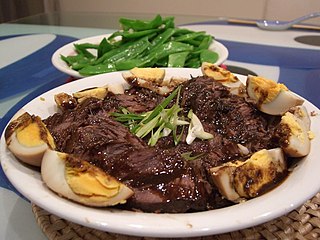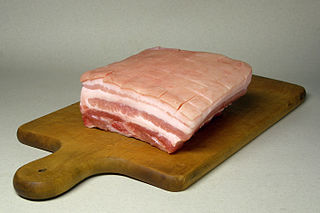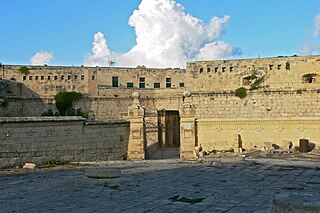
Hares and jackrabbits are mammals belonging to the genus Lepus. They are herbivores, and live solitarily or in pairs. They nest in slight depressions called forms, and their young are able to fend for themselves shortly after birth. The genus includes the largest lagomorphs. Most are fast runners with long, powerful hind legs, and large ears to dissipate body heat. Hare species are native to Africa, Eurasia and North America. A hare less than one year old is called a "leveret". A group of hares is called a "husk", a "down" or a "drove".

Braising is a combination-cooking method that uses both wet and dry heats: typically, the food is first browned at a high temperature, then simmered in a covered pot in cooking liquid. It is similar to stewing, but braising is done with less liquid and usually used for larger cuts of meat. Braising of meat is often referred to as pot roasting, though some authors make a distinction between the two methods, based on whether additional liquid is added. Osso buco and coq au vin are well known braised meat dishes, and the technique can also be used to prepare fish, tempeh, tofu or fruits and vegetables.

Beef noodle soup is a noodle soup made of stewed or braised beef, beef broth, vegetables and noodles. It exists in various forms throughout East and Southeast Asia.
Maltese cuisine reflects Maltese history; it shows strong Italian influences as well as influences from Spanish, French, Provençal, and other Mediterranean cuisines, with some later British culinary influence. Having to import most of its foodstuffs, being positioned along important trade routes, and having to cater for the resident foreign powers who ruled the islands, opened Maltese cuisine to outside influences. The traditional Maltese stewed rabbit is often identified as the national dish.

Pork belly or belly pork is a boneless and fatty cut of meat from the belly of a pig. Pork belly is particularly popular in Filipino, Hispanic, Chinese, Danish, Norwegian, Korean, and Thai cuisine.

Hasenpfeffer is a traditional Dutch and German stew made from marinated rabbit or hare, cut into stewing-meat sized pieces and braised with onions and a marinade made from wine and vinegar.

Daubes are slow-cooked stews, usually of beef, but other meat is sometimes used. The best-known is the bœuf en daube à la provençale, a provençal stew made with cheaper cuts of beef braised in wine, with vegetables, garlic and herbs, and traditionally cooked in a daubière – a braising pot.

Fricassee or fricassée is a stew made with pieces of meat that have been browned in butter then served in a sauce flavored with the cooking stock. Fricassee is usually made with chicken, veal or rabbit, with variations limited only by what ingredients the cook has at hand.

Caspian cuisine is a regional cuisine found in Northern Iran, primarily found in the Mazandaran, Gilan, Alborz, and Golestan provinces. The recipes are diverse, just like the region's landscape. Nature in the Mazandaran region of Iran is distinct and varied sections with a mixture of coastal, plains, prairies, forests, and rainforests. The Mazandarani cuisine of coastal regions is very different from that of mountainous regions since people settled in the Alborz usually use the indigenous herbs, while coastal populations prepare dishes using local fish and Caspian (Mazani) rice with vegetables.

Nigerian cuisine consists of dishes or food items from the hundreds of Native African ethnic groups that comprise Nigeria. Like other West African cuisines, it uses spices and herbs with palm or groundnut oil to create deeply flavored sauces and soups.

Burkinabé cuisine, the cuisine of Burkina Faso, is similar to the cuisines in many parts of West Africa, and is based on staple foods of sorghum, millet, rice, fonio, maize, peanuts, potatoes, beans, yams and okra. Rice, maize and millet are the most commonly eaten grains. Grilled meat is common, particularly mutton, goat, beef and fish.

The Rising of the Priests, also known as the Maltese Rebellion of 1775 and the September 1775 Rebellion, was an uprising led by Maltese clergy against the Order of Saint John, who had sovereignty over Malta. The uprising took place on 8 September 1775, but was suppressed by the Order within a few hours. The rebels were then captured and some were executed, exiled or imprisoned.

A stew is a combination of solid food ingredients that have been cooked in liquid and served in the resultant gravy. Ingredients can include any combination of vegetables and may include meat, especially tougher meats suitable for slow-cooking, such as beef, pork, venison, rabbit, lamb, poultry, sausages, and seafood. While water can be used as the stew-cooking liquid, stock is also common. A small amount of red wine or other alcohol is sometimes added for flavour. Seasonings and flavourings may also be added. Stews are typically cooked at a relatively low temperature, allowing flavours to mingle.

Rabbit stew, also referred to as hare stew when hare is used, is a stew prepared using rabbit meat as a main ingredient. Stuffat Tal-Fenek, a variation of rabbit stew, is the national dish of Malta. Other traditional regional preparations of the dish exist, such as Coniglio all'ischitana on the island of Ischia, German Hasenpfeffer and jugged hare in Great Britain and France. Hare stew dates back to at least the 14th century, and was published in The Forme of Cury during this time as a recipe for stewed hare. Rabbit stew is a traditional dish of the Algonquin people and is also a part of the cuisine of the Greek islands. Hare stew was commercially manufactured and canned circa the early 1900s in western France and eastern Germany.

The cuisine of Cape Verde is a West African cuisine largely influenced by Portuguese, Southern and Western European and West African cuisine. Cape Verde was a colony of Portugal from its colonization until 1975.

Indian Indonesian cuisine is characterized by the mixture of Indian cuisine with local Indonesian-style. This cuisine consists of adaptations of authentic dishes from India, as well as original creations inspired by the diverse food culture of Indonesia. Indian influence can be observed in Indonesia as early as the 4th century. Following the spread of Islam to Indonesia and trading, Muslim Indian as well as Arab influences made their way into Indonesian cuisine. Examples include Indian biryani, murtabak, curry and paratha that influenced Acehnese, Minangkabau, Malay, Palembangese, Betawi and Javanese cuisine.

In cooking and gastronomy, goose is the meat of several species of bird in the family Anatidae. The goose is in the biological family of birds including ducks, and swans, known as the family of Anatidae. The family has a cosmopolitan distribution, and various wild species and domesticated breeds are used culinarily in multiple cuisines. There is evidence as early as 2500 BC of deliberate fattening of domesticated geese in Egypt.
















